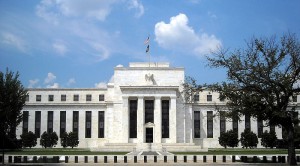 This morning I got up early and, still curious about civic architecture, jogged down Pennsylvania Avenue past the White House, then the headquarters of the US Department of the Treasury (a nineteenth century, white stuccoed neo-classical collonaded temple with a statue of Alexander Hamilton outside) the International Monetary Fund (a stodgy 1970s, monolithic concrete block), the World Bank (a light, stylish and modernistic building from the 1990s) and the Federal Reserve (the 1930s, stripped down neo-classical Eccles building – picture) and then back up the Mall. The contrast between the two Bretton Woods’ institutions (concrete stodge versus airy modernity), which face one another, was interesting. Once back at the hotel I read up a little about the Fed and its history. If I knew, I had forgotten that for three periods in its history (1811-1816, 1837-1862 and 1863-1913) the United States had no Central Bank. It was only when a series of panics threw into relief the inadequacies of the 1863-1913 national banks system that the current Federal Reserve System was established and, even then, another and completely distinct entity, the US Department of the Treasury, creates the currency that the Fed issues. Curious, too, is the Fed’s simultaneously public and private structure and the way it works independently from government but from within it. Also fascinating is the system of twelve Federal Reserve Banks, located in cities that manage districts whose size was determined by population sizes when the Federal Reserve Act was passed in 1913 (thus, ‘San Francisco’ is responsible for a vast geographic area encompassing seven states). Not for the first time, I feel that we Europeans could learn from studying American history.
This morning I got up early and, still curious about civic architecture, jogged down Pennsylvania Avenue past the White House, then the headquarters of the US Department of the Treasury (a nineteenth century, white stuccoed neo-classical collonaded temple with a statue of Alexander Hamilton outside) the International Monetary Fund (a stodgy 1970s, monolithic concrete block), the World Bank (a light, stylish and modernistic building from the 1990s) and the Federal Reserve (the 1930s, stripped down neo-classical Eccles building – picture) and then back up the Mall. The contrast between the two Bretton Woods’ institutions (concrete stodge versus airy modernity), which face one another, was interesting. Once back at the hotel I read up a little about the Fed and its history. If I knew, I had forgotten that for three periods in its history (1811-1816, 1837-1862 and 1863-1913) the United States had no Central Bank. It was only when a series of panics threw into relief the inadequacies of the 1863-1913 national banks system that the current Federal Reserve System was established and, even then, another and completely distinct entity, the US Department of the Treasury, creates the currency that the Fed issues. Curious, too, is the Fed’s simultaneously public and private structure and the way it works independently from government but from within it. Also fascinating is the system of twelve Federal Reserve Banks, located in cities that manage districts whose size was determined by population sizes when the Federal Reserve Act was passed in 1913 (thus, ‘San Francisco’ is responsible for a vast geographic area encompassing seven states). Not for the first time, I feel that we Europeans could learn from studying American history.
Leave a Reply